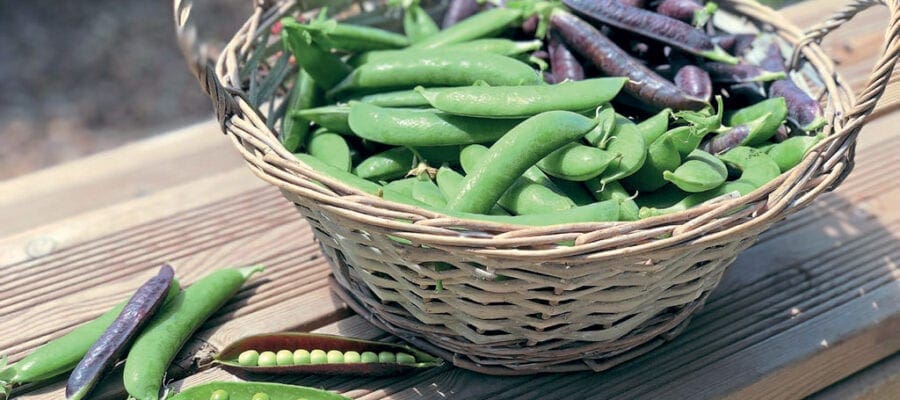
Rob Smith takes a tour of yesteryear with a look at some of his favourite heritage varieties that are neither gone nor forgotten.
We gardeners are inundated with fantastic seed catalogues and an overwhelming number of new varieties of veg to choose from. With this in mind it’s sometimes tough deciding what to grow; after all, we know we want to grow varieties that are tasty and grow well.
So, why not think about varieties which have stood the test of time and have been grown for generations, not just the more modern ones? In particular I’m talking about heritage vegetables!
Open Pollinated
If you’re wondering what heritage veg are, they are varieties that have been around for several decades and normally before the Second World War.
They are also open-pollinated varieties, meaning they are not F1 hybrids. Being open pollinated means that you can save the seed from the varieties you grow and it will produce the same plant as the parent, as opposed to F1 which will start to revert to one of the parent lines used to create it and not produce the same plant from saved seeds.

I always think of heritage varieties as the ones my grandad used to grow on his allotment, saving the seeds and drying them to grow the following year and keeping us in fresh, tasty veg along the way. They are a flavour of what veg used to taste like and I love them!
Where to start
When it comes to growing heritage veg there are several places to start, with many seed companies having a heritage range or telling you when the variety was discovered or released. In fact a simple internet search will give you lots of places to buy some wonderful and unusual varieties, with Pennard Plants, Dobies, The Organic Gardening Catalogue, Real Seeds and Thomas Etty having a vast array that would fill your garden or allotment 10 times over.
There is also, of course, the fantastic Heritage Seed Library which is part of Garden Organic; they preserve old varieties and stop them becoming extinct.
Home Growing
Heritage varieties are particularly suited to growing at home or on the allotment as their harvest period is normally over a far longer time than the modern varieties.
Modern types were developed to be harvested all at once, primarily for the supermarket trade and usually by machine, giving the farmer more crops all at once and saving on time and money.

The older varieties may ripen over a few weeks, meaning you don’t have to cope with 10 cauliflowers or cabbages in one go; rather you get two a week for a month or so, perfect for the average family.
Non-PC
When it comes to some of the older varieties you have to remember the era in which they were released and appreciate they may not have what we would usually think of as a PC name, some having tongue-in cheek names for the variety they are describing.
For example lettuces, such as ‘Fat Lazy Blonde’ and ’Drunken Woman’. This is something that you either accept or don’t, but please don’t judge these wonderful varieties by their old-fashioned names – judge them on flavour once you’ve grown them.
Prize Leeks
If peas aren’t your thing, what about leeks? ‘Musselburgh’ is a variety you will find on most allotment sites up and down the country because of its ability to produce good thick stems. This variety has a fantastic flavour and will grow almost anywhere.

Yet did you know it is a heritage variety dating back to the 1820s? Another favourite which is still used on the show bench is ‘Prizetaker’, introduced in the UK in 1886 and perfect to grow if you want a handsome and tasty leek in the autumn.
‘Blauwschokker’
Heritage varieties may also grow in a different way to more modern varieties and can use less floor space as they grow upwards, perfect for today’s smaller gardens; for example, the pea ‘Blauwschokker’ (which is a purple-podded old German variety) can grow to around eight feet tall!
Not suited to modern farming, where they like the plants to be short and easy for a machine to pick all the pods at once, instead, this tall variety can be grown like runner beans and will produce countless bright purple pods.
These are easy to see on the plants as they stand out from the green foliage, perfect for a home grower who wants to pick enough peas for that evening’s meal.
‘Champion of England’
Most heritage varieties also have rather entertaining histories which can be part of the reason why they are still grown; none more so than another pea, ‘Champion of England’.

This sweet and productive climbing pea (up to 2m/7ft) was even grown by Charles Darwin and classed as ‘The Best Pea’ in the Horticultural Journal (before the RHS) more than 100 years ago. In fact, ‘Champion of England’ was first listed in 1843 yet went out of favour as shorter, more manageable varieties were bred.
It was eventually saved by the Heritage Seed Library and reintroduced in the last couple of years for us home gardeners to enjoy and I don’t think there is a finer pea. Just make sure you grow them up a sturdy structure and you’ll be rewarded with lots of bright green pods filled with sweet and flavoursome peas.
….For the full feature, pick up the January issue of Kitchen Garden. For more information on how to get your hands on a copy, click HERE.











